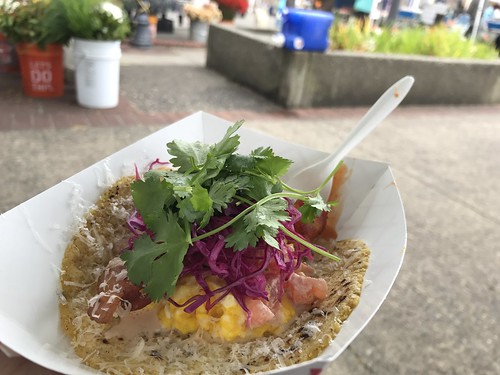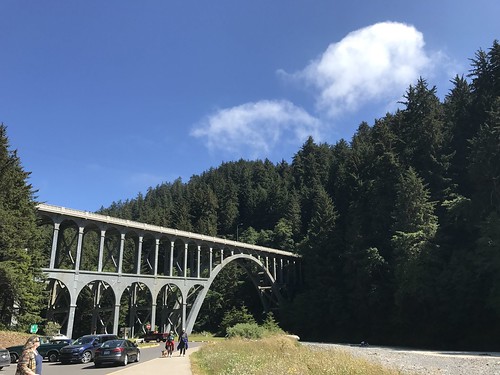Week 3: Tillamook 101
The Lead Up
Following the holiday this week (which we enjoyed with firework-viewing and snacks on the beach) I traveled 4 hours north to accompany Tony at the Tillamook Estuary Partnership’s (referred to hereafter as TEP) meeting to discuss their Comprehensive Conservation and Management Plan (CCMP).
TEP is a non-profit organization consisting of many partner groups from federal and more local levels- from Oregon Department of Forestry to Bureau of Land Management to Oregon Department of Agriculture- that exists to conserve and restore Tillamook County’s estuaries and watersheds. This is no small feat, as there are 5 different bays and estuaries that fall under their protection, the largest of them being Tillamook Bay which holds a designation as a “Bay of National Significance” for its role as an economic and ecological resource. For more background on the watersheds themselves and TEP see here: http://www.tbnep.org/about-us.php.
The premise of this meeting was to revise the existing nearly 20-year-old document that serves as the current CCMP. So, my first step to prepare for attendance was to read over and take notes on the ten-odd chapters of the old plan, as well as several pdf documents Tony had sent me that encompassed the planning thus far. When they call this plan “comprehensive” they aren’t kidding. It was a lot of reading about many different aspects of resource management, with focus on four main issues: water quality, habitat loss/simplification, erosion/sedimentation, and flooding. Beyond that, it included a section on the implementation and financing of the plan (money makes the world go ‘round), as well as future research needs. Since my internship surrounds the assessment of shellfish and their habitat, I paid extra close attention to sections regarding those animals. I gathered that Tillamook has a long history of commercial oyster fishing and clamming as well as recreational use.
Armed with my notes, I packed my bag and started my journey to Newport, where I’d be meeting Tony and we’d carpool the rest of the way to Tillamook. I took advantage of my early start and use of the state vehicle and made a pit stop at the Coos Bay farmer’s market (which for some odd reason is held on Wednesday mornings). After picking up some blackberries and the most beautiful breakfast taco I’ve ever seen (pictured below), I was on my way. The drive was very scenic and went well despite the on and off radio availability and bridge construction. On the second leg of the trip Tony drove and talked to me about the history of each town we went through on U.S. Route 101, which basically forms the main road in all of those towns (makes for slow driving). The 101, or Oregon Coast highway here, is teeming with tourists in the summer months, which is no surprise considering it accesses more than 80 state parks along its length. The amount of hotels and resorts was a little perplexing to me, as the climate here does not really meet my expectations for a beach side vacation, but nonetheless most signs read no vacancy. And don’t even get me started on the R.V.s / R.V. parks. R.V.s far as the eye can see. We didn’t have a set time for arrival to Tillamook since the meeting was not till the next morning, so we made a few stops to stretch/check out the scenery. We pulled onto the beach in Pacific City (you can drive on the beaches here!) to take a look at Chief Kiawanda Rock- basically a huge rock standing by its lonesome just off the beach. Pretty neat. Once in Tillamook, we ate dinner and checked into the hotel. I was spoiled with my own king bed and hot tub privileges for a night. All in the name of science. :)
The Meeting
The meeting was held at the local community college in a nice big conference room which could comfortably seat the 20 or so members that showed up. Tony and I were first to arrive, and I was introduced to Lisa Phipps, director of the TEP. She had tacked large sheets of paper all over the front of the room, some with writing and some to be written on later. I took a look at the proposed agenda and could understand why it was predicted to be a 3-hour meeting. There was a lot to cover.
The meeting began with introductions, and I got an idea for how many representatives of each partner group were present. Some had more than others but there was definitely a lot of diversity. They proceeded to reiterate some of the decisions discussed in the previous meeting to give everyone a refresher and then got to work on the agenda items. An example of one such item was the proposal to reorganize the management units. Before the plan had been sectioned by issue, but the proposed change was to break it down by land use; dividing the estuaries into upper, lower, and head of tide, and then address problems specific to those areas. This was the first exchange of ideas I saw, as there was a discussion on what distinction to use to make the land divisions- By salinity or by bacterial line? Several people stated their opinions and gave advice on specific terminology to use in the document. That was how the entire proceedings went on: a question or issue was presented, then they would brainstorm, Lisa would write, and so on. It was step by step decision making, and as we went down the board I began to see who weighed in on what issues, who was knowledgeable about each category. For example, the “forest people” may not give any input regarding burrowing shrimp on the mud flats. The atmosphere was friendly and professional; people gave honest feedback, freely voiced their concerns, and addressed misconceptions if they arose.
Takeaways
I learned a lot from this experience, not only on issues specific to Tillamook but about how these sorts of meetings operate in general. I learned how much the waterways there are influenced by agriculture, and that managing land owners is a very dynamic process. I learned that the TEP’s future goals focus on being more proactive than reactive, which will require more outreach and public education. They also want to identify data gaps where more research may be needed. I learned that making a plan like this has to be so all-encompassing because they are planning for the next decade, and this document will be referred to for grant funding throughout that timeframe. I even got to speak up during the meeting, when Oregon Department of Agriculture reps were discussing the role of “hobby farmers” and the expectation that they follow responsible land use practices even though they’re not held as accountable as large industry farmers. One woman brought up the difficulty in knowing just how many people own animals and making sure they are informed. I asked if there was an online resource available to those people, and suggested that they incorporate a place where hobby farmers could register themselves, submit a plan of action, and get their questions answered all on one site. My comments were very well-received and I was glad I had raised my hand (even if my bright red face begged to differ). There are still a few meetings left till the CCMP document can be written up, but it will eventually be submitted to the EPA for approval. I am thankful I got to participate in the meeting and get my first taste of resource management on a large scale (getting out of field work and driving a car again weren’t bad perks either).
Here are some photos of me enjoying the scenic 101.
On to week 4!
-Katie Gregory








Traveling all the way to Tillamook means you’ve seen most of the Oregon coastline! Isn’t Pacific City beautiful? Absolutely love the inclusion of a photo of your beautiful breakfast taco, it looks delicious. That sounds like an awesome meeting that you got to sit in on and see how management works in action, and all of the different groups involved in it. I’m so impressed that you even spoke up! I’m not sure I would have that kind of courage just a couple weeks into my internship, plus you made a smart and applicable contribution to the group. Keep it up!
I want to be you when I grow up
It was all beautiful! Definitely one of the most scenic drives I’ve experienced. And haha, right?! That taco was meant for the world to see. Thanks, Haley!
You have imparted wisdom on me Ms. Enzmann, so who is the real idol?